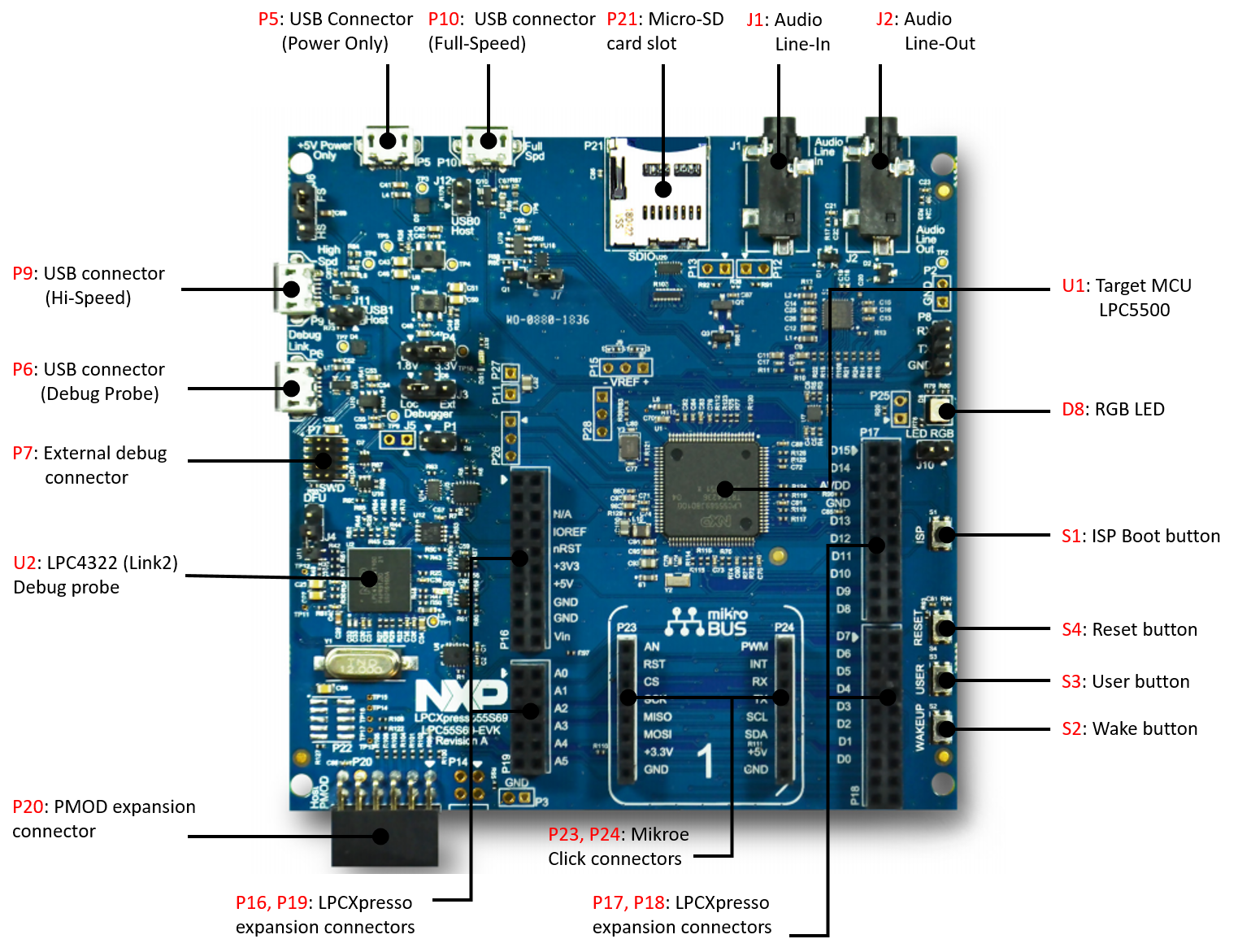Getting Started with the LPC55S28-EVK Evaluation Board
Contents of this document
-
Plug It In
-
Get Software
-
Build, Run
-
Modify a SDK Example
Sign in to save your progress. Don't have an account? Create one.
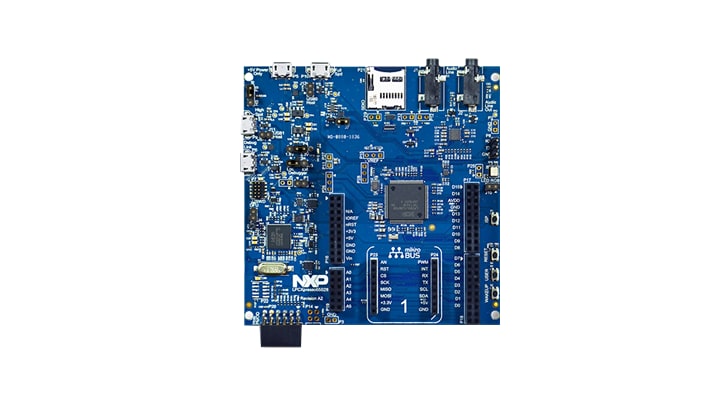
Purchase your LPC55S28-EVK
1. Plug It In
1.1 Get Familiar With the Board
Let's take your LPCXpresso55S28 for a test drive You have the choice of watching the sequence in a short video or following the detailed actions listed below.
1.2 Attach the USB Cable
There are four micro-USB connectors on the board. One each for Full and High Speed USB, one for supplying power only and one for debug. Plug the USB cable into the one labeled +5 V Power only as shown in the photo.

1.3 Run the Out-of-Box Demo
Your LPCXpresso55S28 board comes loaded with a simple switch led demo, explained below, and an audio demo describes in the next section.
The board is working if the green LED in the RGB-LED flashed with a 1 Hz rate. A Switch LED Demo:
- Press the [WAKEUP] button. Verify that the blue LED in the RGB-LED is constant on while pressing
- Press the [USER] button. Verify that the green LED on the RGB-LED is constant on (with only short off-flashes)
- Press [ISP] button. Verify that the red LED in the RGB-LED is constant on while pressing
- Press [RESET] button. Verify that the RGB-LED turns off while pressing
2. Get Software
2.1 Installing Software for LPCXpresso55S28
2.2 Jump Start Your Design with the MCUXpresso SDK
The MCUXpresso Software Development Kit (SDK) is complimentary and includes full source code under a permissive open-source license for all hardware abstraction and peripheral driver software.
Click below to download a pre-configured Windows SDK release for the LPCXpresso55S28, which includes IDE support for MCUXpresso, Keil MDK, GCC ARM Embedded and IAR Embedded Workbench.
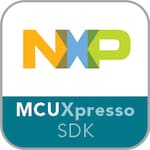
You can also use the online SDK Builder to create a custom SDK package for the LPCXpresso55S28.
2.3 Install your Toolchain
MCUXpresso IDE is development platform ecosystem from NXP. It provides an end-to-end solution enabling engineers to develop embedded applications from initial evaluation to final production.
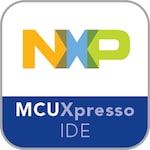
Want to use a different toolchain?
No problem The MCUXpresso SDK includes support for other tools such as IAR , Keil and command-line GCC .

2.4 MCUXpresso Config Tools
The MCUXpresso Config Tool is an integrated suite of configuration tools that guides users in creating new MCUXpresso SDK projects, and also provides pin and clock tools to generate initialization C code for custom board support, It is fully integrated into MCUXpresso or you can download a seperate tool.
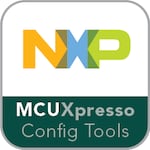
To learn more about the basic interactions between the tools while working with either an imported MCUXpresso SDK example project or creating a new project within the IDE, watch this three-part video series: Basic Application Development Using MCUXpresso IDE and MCUXpresso Config Tools .
2.5 Debug Probe Firmware Update Using LPCScrypt
To set up your LPCXpresso55S28 for use with 3rd party tools, first install LPCScrypt in order to install the board's device drivers. The video below shows how to use LPCScrypt to program your board's debug probe using this utility.
2.6 Serial Terminal
Many of the MCUXpresso SDK examples applications output data over the MCU UART. Make sure you install serial drivers with LPCScrypt from step 2.3.
Not sure how to use a terminal application? Try one of these tutorials: MCUXpresso Terminal, Tera Term Tutorial and PuTTY Tutorial.
3. Build, Run
3.1 Explore the MCUXpresso SDK Example Code
The MCUXpresso SDK comes with a long list of example applications code. To see what's available, browse to the SDK boards folder of your SDK installation and select LPCXpresso55S28 (<SDK_Install_Directory>/boards/lpcxpresso55s28).
To learn more about specific example code, open the readme.txt file in an example's directory.
3.2 Build, Run
Using a different toolchain?
4. Modify a SDK Example
4.1 Clone an Example Project from MCUXpresso SDK
Option A: Use the MCUXpresso IDE to clone an example project.
Use MCUxpresso IDE
Build an Example Application
The following steps will guide you through opening the sctimer pwm duty cycle change example. The example sets up a PWM signal and periodically updates the signals duty cycle.
- Find the Quickstart Panel in the lower left-hand corner
- Then click on Import SDK examples(s)
- Click on the LPCXpresso55S28 board to select that you want to import an example that can run on that board, and then click on Next
- Use the arrow button to expand the driver_examples category, then expand the sctimer examples, click on the check box next to sctimer_pwm_with_dutycycle_change to select it. To use the UART for printing (instead of the default semihosting), Select UART as the SDK Debug Console checkbox under the project options. Then, click on Finish
- Click on the “lpcxpresso55s28_sctimer_pwm_with_dutycycle_change” project in the Project Explorer View and build, compile, and run the demo as described previously
- You should see a change in LED brightness if a LED is connected to the SCTimer output pin, otherwise, you could see the change of the duty cycle using an oscilloscope
- Terminate the debug session






Option B: Use the MCUXpresso Config Tool to clone an existing MCUXpresso SDK example for use with third-party IDEs.
Use MCUXpresso Config Tools
Build an Example Application
The following steps will guide you through opening the sctimer pwm duty cycle change example. The example sets up a PWM signal and periodically updates the signal duty cycle.
- Find the Quickstart Panel in the lower left-hand corner
- Then click on Import SDK examples(s)
- Click on the LPCXpresso55S28 board to select that you want to import an example that can run on that board, and then click Next
- Use the arrow button to expand the driver_examples category, then expand the sctimer examples, click on the checkbox next to sctimer_pwm_with_dutycycle_change to select it. To use the UART for printing (instead of the default semihosting), Select UART as the SDK Debug Console checkbox under the project options. Then, click Finish
- Click on the “lpcxpresso55s28_sctimer_pwm_with_dutycycle_change” project in the Project Explorer View and build, compile and run the demo as described previously
- You should see a change in LED brightness if a LED is connected to the SCTimer output pin, otherwise, you could see the change of the duty cycle using an oscilloscope
- Terminate the debug session






4.2 Use the Pin Tool
Now, let's use the Pins tool that is part of the MCUXpresso Config Tool to show how to add a new GPIO pin to your project to blink an LED.
Use MCUXpresso IDE Pins Tool
To open pin tools in MCUXpresso IDE:
- Open the pins tool by right clicking on the “lpcxpresso55s28_sctimer_pwm_dutycycle_change” project, and selecting “MCUXpresso Config Tools” and then “Open Pins”
- The pins tool should now display the pin configuration for the pwm project


To open pin tools in MCUXpresso Config tools:
- Open the MCUXpresso Config Tool
- In the wizard that comes up, select the “Open existing configuration” radio button, then select the project that you had clone and click on Next
- Open the pins tool by selecting Tools → Pins from the toolbar
- The pins tool should now display the pin configuration for the pwm project



Use the pins tools to modify the SCT routed pin:
- We'll use MCUXpresso IDE for the rest of the instructions, but the same steps can be done in MCUXpresso Config tools for third party IDEs. In the Pins view deselect the “Show not routed pins” checkbox to see only the routed pins, you also going to see the pins that are routed by default. Routed pins have a check in a green box next to the pin name. The functions selected for each routed pin are highlighted in green
- In the current configuration, PIO0_15 is routed as a SCT0_OUT2. Let's disable, PIO0_15, and change the mux setting of PIO1_4 to use its SCTimer functionality to drive the blue LED
- Disable, PIO0_15 as a SCTIMER by clicking the “SCT0_OUT2” field under the SCT column. The pin will then be disabled (pin will no longer have check in box) and thus disappear from the list
- Now, route PIO1_4 as a SCTIMER. First, select the “Show not routed pins” so that all the pins are displayed again. Then, search PIO1_4 in the pins view. Finally, click the box under the SCTIMER column “SCT0_OUT0”. The box will highlight in green, and a check will appear next to the pin
- Now it's time to implement these changes into the project by exporting the new updated pin_mux.c and pin_mux.h files that are generated by the Pins tool. Click on Update Project in the menu bar
- The screen that pops up will show the files that are changing and you can click on “diff” to see the difference between the current file and the new file generated by the Pins tool. Click on “OK” to overwrite the new files into your project.
- Now inside the IDE, open the
sctimer_update_dutycycle.cfile - Note that when we change the sctimer routed pin in the tool the PIO0_15 use SCT_OUT4 while the PIO1_4 (blue led) use SCT_OUT0, we are going to change the “DEMO_SCTIMER_OUT” macro from “kSCTIMER_Out_2” to “kSCTIMER_Out_0”
- Build and download the project as done in the previous section
- Run the application. You should now see the blue LED acts as a "breathing”
- Terminate the debug session







4.3 Use the Clocks Tool
Next use the Clocks tool that is part of the MCUXpresso Config Tool to change the clock settings and change the rate that the LED blinks.
Use MCUXpresso IDE Clock Tools
To open clock tools in MCUXpresso IDE:
- Open the Clock tool by right clicking on the “lpcxpresso55s28_sctimer_pwm_with_dutycycle_change” project and selecting “MCUXpresso Config Tools” and then “Open Clocks”
- The clock tool should now display the pin configuration for the project


To open clock tools in MCUXpresso Config tools:
- Open the MCUXpresso Config Tool
- In the wizard that comes up, select the “Open existing configuration” radio button, then select the project that you had clone and click on Next
- Open the clocks tool by selecting Tools → clocks from the toolbar
- The pins tool should now display the pin configuration for the pwm project



Use the clock tools to modify the system clock:
- We'll use MCUXpresso IDE for the rest of the instructions, but the same steps can be done in MCUXpresso Config tools for third party IDEs. Switch to the Clocks Diagram view by clicking the tab in the upper left corner
- Make sure that you are in the functional group called “BOARD_BootClockFROHF96M”
- Change the core clock frequency by clicking in the Systems Clock field and typing “12”. You'll see all the other clock values automatically change as well to adjust to this slower speed. It will look like this when done:
- Now it's time to implement these changes into the project by exporting the new updated
clock_mux.candclock_mux.hfiles that are generated by the Pins tool. Click on Update Project in the menu bar -
The screen that pops up will show the files that are changing and you can click on “diff” to see the difference between the current file and the new file generated by the Clock tool. Click on “OK” to overwrite the new files into your project.
Note: The Pins files may also be tagged as being updated since the header has been changed.
- Build and download the project as done in the previous section
- Run the application. You should now see the blue LED acts as “breathing” a much slower rate
- Terminate the debug session





4.4 Success
With the application modified, you will see the LPCXpresso55S28 RGB blue LED acts as "breathing" slowly.
MCUXpresso Terminal
MCUXpresso Terminal
The most recent versions of MCUXpresso IDE count with a terminal emulation application. This tool can be used to display information sent from your NXP development platform's virtual serial port.
- Open the MCUXpresso IDE
- Launch the MCUXpresso IDE terminal by clicking on the “Open a Terminal” button on the top of the IDE or press “Ctrl + Alt + Shift + T”
- Select Serial Terminal
- Configure the serial port settings (using the LPCXpresso COM port number) to 115200 baud rate, 8 data bits, no parity and 1 stop bit, then press “OK” button
- Verifythat the connection is open. If connected, MCUXpresso IDE will look like the figure below at the Terminal view
- You're ready to go





Tera Term Tutorial
Tera Term Tutorial
Tera Term is a very popular open source terminal emulation application. This program can be used to display information sent from your NXP development platform's virtual serial port.
- Download Tera Term from SourceForge. After the download, run the installer and then return to this webpage to continue
- Launch Tera Term. The first time it launches, it will show you the following dialog. Select the serial option. Assuming your board is plugged in, there should be a COM port automatically populated in the list
- Configure the serial port settings (using the COM port number identified earlier) to 115200 baud rate, 8 data bits, no parity and 1 stop bit. To do this, go to Setup → Serial Port and change the settings
- Verify that the connection is open. If connected, Tera Term will show something like below in it's title bar
- You're ready to go
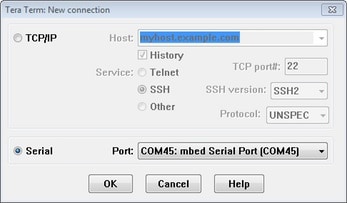

Putty Tutorial
Putty Tutorial
PuTTY is a popular terminal emulation application. This program can be used to display information sent from your NXP development platform's virtual serial port.
- Download PuTTY using the button below. After the download, run the installer and then return to this webpage to continue
- Launch PuTTY by either double-clicking on the
*.exefile you downloaded or from the Start menu, depending on the type of download you selected - Configure In the window that launches, select the Serial radio button and enter the COM port number that you determined earlier. Also enter the baud rate, in this case 115200
- Click Open to open the serial connection. Assuming the board is connected and you entered the correct COM port, the terminal window will open. If the configuration is not correct, PuTTY will alert you
- You're ready to go
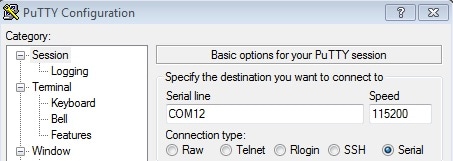
Security and Integrity
The LPC55S28 is secure-by-design and supported by secure software driving the secure System on a Chip (SoC).
| Documents and Videos | Description |
|---|---|
| AN12278 LPC55S00 Security Solutions for IoT | This document lays out the differences and advances in the security systems for each LPC55Sxx MCU. |
| AN12324 LPC55Sxx usage of the PUF and Hash Crypt to AES coding | How to securely generate, store and retrieve user keys using the root key. |
| AN12445 Asymmetric Cryptographic Accelerator CASPER | This document introduces the Cryptographic Accelerator and Signaling Processing Engine with RAM-Sharing (CASPER) on security devices of LPC55S2x series. The CASPER peripheral provides acceleration to asymmetric cryptographic algorithms as well as to certain signal processing algorithms. |
| AN12527 LPC55Sxx PRINCE Real-time Data Encryption | The PRINCE algorithm is used for real-time encrypt/decrypt operation on LPC55Sxx on-chip flash contents. This functionality is useful for asset protection, such as securing application code, securing data, and enabling secure flash update. |
MCUXpresso SDK Examples
Several examples, demos and drivers are available within the SDK to help you get started. Some common examples related to security are listed below.
CASPER Examples
A demonstration program that uses the KSDK software implement modular exponentiation algorithm using the CASPER software driver.
Path:
<SDK_PATH>/boards/lpcxpresso55s28/driver_examples/casperHashcrypt Examples
A demonstration program that uses the KSDK software to encrypt plain text and decrypt it back using AES and SHA algorithm.
Path:
<SDK_PATH>/boards/lpcxpresso55s28/driver_examples/hasycryptPRINCE Examples
How to setup PRINCE driver for the on-the-fly encryption/decryption of data stored in the internal flash memory.
Path:
<SDK_PATH>/boards/lpcxpresso55s28/driver_examples/princePUF
A demonstration program that uses the KSDK software implement secure key storage using PUF software driver.
Path:
<SDK_PATH>/boards/lpcxpresso55s28/driver_examples/pufRNG
A demonstration program that uses the KSDK software to generate random numbers and prints them to the terminal.
Path:
<SDK_PATH>/boards/lpcxpresso55s28/driver_examples/rng> Tools and References
MCUXpresso Secure Provisioning Tool A GUI-based application provided to simple generation and provisioning of bootable executables on NXP MCU devices.
Wired Communications
| Documents and Videos | Description |
|---|---|
| Using ConfigTool to Create USB Project From Start | Creating a USB project with MCUXpresso Config Tool and the LPCXpresso55S28-EVK. |
| TN00071 USB Detection with Full-Speed Hubs | On the LPC55xx devices, there is an errata when using USB High Speed Device controller with Full-Speed Hub. This technical note describes the software workaround and how to use the USB PHY Receiver Control (RX) register to ensure detection of the correct host speed during the USB connection stage. |
| TN00063 LPC5500 Crystal-less USB Solution | This technical note explains the steps required to modify the software to integrate a crystal-less USB device operation in full-speed mode in the LPC5500 application. |
MCUXpresso SDK Examples
Several examples, demos and drivers are available within the SDK to help you get started. Some common examples related to wired communications are listed below.
Shell Demo (UART example)
Demonstrates how to implement a command line shell application.
Path:
<SDK_PATH>/boards/lpcxpresso55s28/demo_apps/shell Driver Examples
A number of driver examples exist within the SDK including GPIO, I²C, I²S, SPI and USART.
Path:
<SDK_PATH>/boards/lpcxpresso55s28/driver_examples SDMMC Examples
Multiple examples that show how to use interrupt or polling-based transfer API in SDHC driver to access the SD card and using the SDCARD driver based FATFS disk in SDK software.
Path:
<SDK_PATH>/boards/lpcxpresso55s28/sdmmc_examples USB Examples
A number of USB examples for host and device operation exist within the SDK.
Path:
<SDK_PATH>/boards/lpcxpresso55s28/usb_examples Wireless Connectivity
| Documents and Videos | Description | Aplication Note Software |
|---|---|---|
| AN12805 Establish Secure Connection with Private Cloud | How to create a secure embedded software project with the LPCXpresso55S28 board. | Download |
| Connecting the LPC55S69 to Amazon Web Services | Demo focused on the WIFI enablement and cloud connectivity through AWS using MCUXpresso and an Amazon Alexa. | - |
| How to Add Peripherals to AWS IOT and Alexa Skills | Step-by-step approach to adding peripherals to your AWS IOT and Alexa Skills project. | - |
| Amazon FreeRTOS Documentation | FreeRTOS is a market-leading real-time operating system (RTOS) for microcontrollers and small microprocessors. Find resources here included users guide, API reference, porting guide and qualification guide. | - |
| AWS IoT Developer Guide | AWS IoT provides device software that can help you integrate your IoT devices into AWS IoT-based solutions. | - |
MCUXpresso SDK Examples
Several examples, demos and drivers are available within the SDK to help you get started. A common example related to wireless connectivity is listed below.
NTAG I²C Explorer Blink
Shows use of NT3H2111_2211 NTAG I²C plus Connected NFC Tag with I²C Interface Chip and demonstrates basic communication with the device.
Path:
<SDK_PATH>/boards/lpcxpresso55s69/ntag_i2c_plus_examples/ntag_i2C_explorer_blink Wi-Fi Serial Demo and Wi-Fi Serial iPerf Example
The serial demo shows usage of SerialMWM Wi-Fi module connected over UART interface. The iperf example provides basic commands to measure performance of network stack.
Path:
<SDK_PATH>/boards/lpcxpresso55s28/wifi_examples Shadow Wi-Fi Example
The simple lightbulb example illustrates how client application and things communicate with the Shadow service.
Path:
<SDK_PATH>/boards/lpcxpresso55s28/aws_examples/shadow_wifi_serial Multicore and Hardware Acceleration
The LPC55S28 includes an Arm® Cortex® M-33 core running up to 150 MHz. In addition, it offers a crypto engine, which is the Cryptographic Accelerator and Signaling Processing Engine with RAM-Sharing (CASPER) peripheral providing acceleration to asymmetric cryptographic algorithms as well as to certain signal processing algorithms.
| Documents and Videos | Description |
|---|---|
| AN12445 Asymmetric Cryptographic Accelerator CASPER | This document introduces the Cryptographic Accelerator and Signaling Processing Engine with RAM-Sharing (CASPER) on security devices of LPC55S2x series. The CASPER peripheral provides acceleration to asymmetric cryptographic algorithms as well as to certain signal processing algorithms. |
MCUXpresso SDK Examples
Several examples, demos and drivers are available within the SDK to help you get started. A common example related to multicore and hardware acceleration is listed below.
CASPER Examples
A demonstration program that uses the KSDK software implement modular exponentiation algorithm using the CASPER software driver.
Path:
<SDK_PATH>/boards/lpcxpresso55s28/driver_examples/casper Audio
| Documents and Videos | Description |
|---|---|
| AN12939 Implementation of 5.1-channel Audio Solution on LPC55xx | The on-board DSP accelerator makes the LPC55S28 very suitable for USB audio applications. |
Quick Audio Demo
For this demonstration you will need:
- A line level audio source like a phone or tablet
- A stereo audio cable to connect the audio source to the LPC55S28 board
- Stereo audio headphones
Plug in an audio source from your phone or tabled headphones to the [Audio Line In] connector and connect headphones to the [Audio Line Out].
When audio is provided to the input you can listen to the audio on the headphones.
MCUXpresso SDK Examples
Several examples, demos and drivers are available within the SDK to help you get started. Some common examples related to audio are listed below.
Audio Demos
Bare metal and FreeRTOS examples that enumerate a recording or playback device. USB Device: Audio generator, audio speaker, composite hid audioUSB Host: Audio Speaker
Path:
<SDK_PATH>/boards/lpcxpresso55s69/usb_examplesI²S Examples
DMA and Interrupt transfer examples show how to use one I²S interface to continuously playback the sine wave to output.Path:
<SDK_PATH>/boards/lpcxpresso55s69/driver_examples/i2s Display and Graphics
| Documents and Videos | Description |
|---|---|
| Graphical User Interfaces for NXP Microcontrollers | Learn more about your GUI options for NXP Microcontrollers. |
| GitHub project using LPC55S69 with Adafruit Touch LCD | Project demonstrating how to add and use a capacitive touch screen with the LPC55S69-EVK. |
| Open Source LittlevGL GUI Library on Adafruit Touch LCDs with NXP LPC55S69-EVK | Driving Adafruit LDC Display with Capacitive Touch and MCULib. |
| LVGL Open-Source Graphics Library | LVGL is a free and open-source embedded graphic library with features that enable you to create embedded GUIs with intuitive graphical elements, beautiful visual effects and a low memory footprint. |
| GUI Guider | A user-friendly graphical user interface development tool from NXP that enables the rapid development of high quality displays with the open-source LVGL graphics library. |
| NXP emWin Libraries | NXP has partnered with SEGGER Microcontroller to offer the high performance emWin embedded graphics libraries in binary form for free commercial use with any Arm Cortex-M microcontrollers from NXP. |
| GUI Development With emWin and AppWizard | How to use the different features in AppWizard to create complete, ready-to-run projects based on emWin. |
| AN12732 HDMI-CEC Implementation on LPC5500 Series | How to implement High-Definition Multimedia Interface (HDMI)-Consumer Electronics Control (CEC) functions as a TV set or a projector that support the HDMI-CEC protocol based on LPC5500 series with GPIO and SCT used. |
MCUXpresso SDK Examples
Several examples, demos and drivers are available within the SDK to help you get started. Some common examples related to display and graphics are listed below.
LVGL Examples
A demo application to show littlevgl widgets.
Path:
<SDK_PATH>/boards/lpcxpresso55s28/littlevgl_examplesemWin GUI Demo
Demonstrates the graphical widgets of the emWin library.
Path:
<SDK_PATH>/boards/lpcxpresso55s28/emwin_gui_demoCamera Interfaces
Camera Interfaces
| Documents and Videos | Description | Application Note Software |
|---|---|---|
| AN12868 Camera Interface in LPC55(S)xx | Introduces the camera interface, features and API routines and demo. | Download |
Motor Control
Motor control is a complicated and advanced topic, with a wide range of intricacies and pitfalls that depend on motor type, number of motors and sensored or sensorless motor drivers.
NXP has a number of ready-to-use motor control algorithms [NOTE: middleware], and the best way to get started is with the FreeMaster examples included in the SDK. These examples utilize the FreeMASTER Run-Time Debugging Tool – user-friendly real-time debug monitor and data visualization tool that enables runtime configuration and tuning of embedded software applications.
| Documents and Videos | Description |
|---|---|
| FreeMASTER How To | A starting guide for engineers using FreeMASTER tool. |
| FreeMASTER 3.0 - Installation Guide | This article will walk you through the installation process of FreeMASTER 3.0. |
MCUXpresso SDK Examples
Several examples, demos and drivers are available within the SDK to help you get started. Some common examples related to Motor Control are listed below.
FreeMASTER Examples
Watch variables and graphs over various interface options.
Path:
<SDK_PATH>/boards/lpcxpresso55s28/freemaster_examplesTools and References
FreeMASTER Communication Driver User’s Guide - Describes the embedded-side software driver which implements a serial interface between the application and the host PC and covers the native Serial UART communication and CAN communication for the applicable devices.
Path:
<SDK_PATH>/middleware/freemaster/doc/user_guideDesign Resources
Board Documents
Chip Documents
Support
Training
| Documents and Videos | Description |
|---|---|
| Basic Application Development Using MCUXpresso IDE and MCUXpresso Config Tools | This three-part video series covers the basic interactions between the MCUXpresso IDE and Config Tools when working with either an imported SDK example project or creating a new one. |
| Hardware Design Guidelines for LPC55(S)xx Microcontrollers | This document guides the hardware engineers to design and test their LPC55(S)xx processor-based designs. The document provides information about board layout recommendations and design checklists to ensure first pass success and avoid board bring-up problems. |
| Flash Programming Tips for LPC5500 Series | Compared with legacy LPC parts, LPC4300, LPC54000, LPC1800, LPC800, the LPC5500 uses new flash IP and is enabled with ROM API driver. Lots of new features have been introduced into this new series. At the same time, it might be a little complicated for new users to operate LPC5500 series' flash. This document aims to remove those barriers and give some useful tips for users. |
| AWS Training | Training programs and offerings from the experts at AWS. |
| LPC55S28 Training | Full list of on-demand training, how-to videos and webinars from NXP about this product. |
Forums
Connect with other engineers and get expert advice on designing with the LPC55 family on one of our community sites.
On this page
- 2.1
Installing Software for LPCXpresso55S28
- 2.2
Jump Start Your Design with the MCUXpresso SDK
- 2.3
Install your Toolchain
- 2.4
MCUXpresso Config Tools
- 2.5
Debug Probe Firmware Update Using LPCScrypt
- 2.6
Serial Terminal
